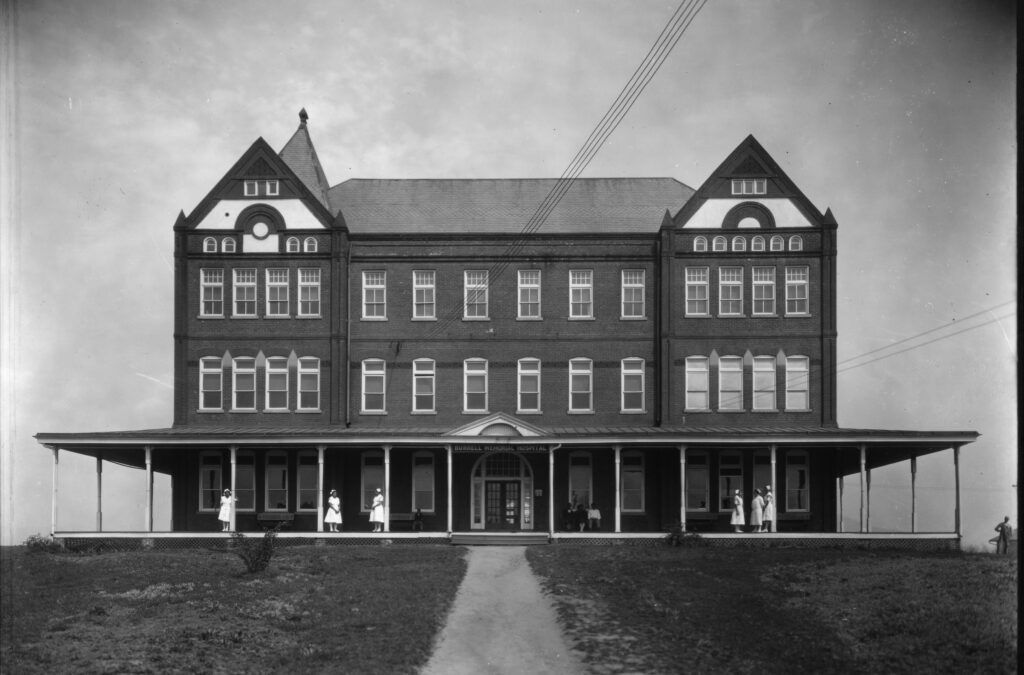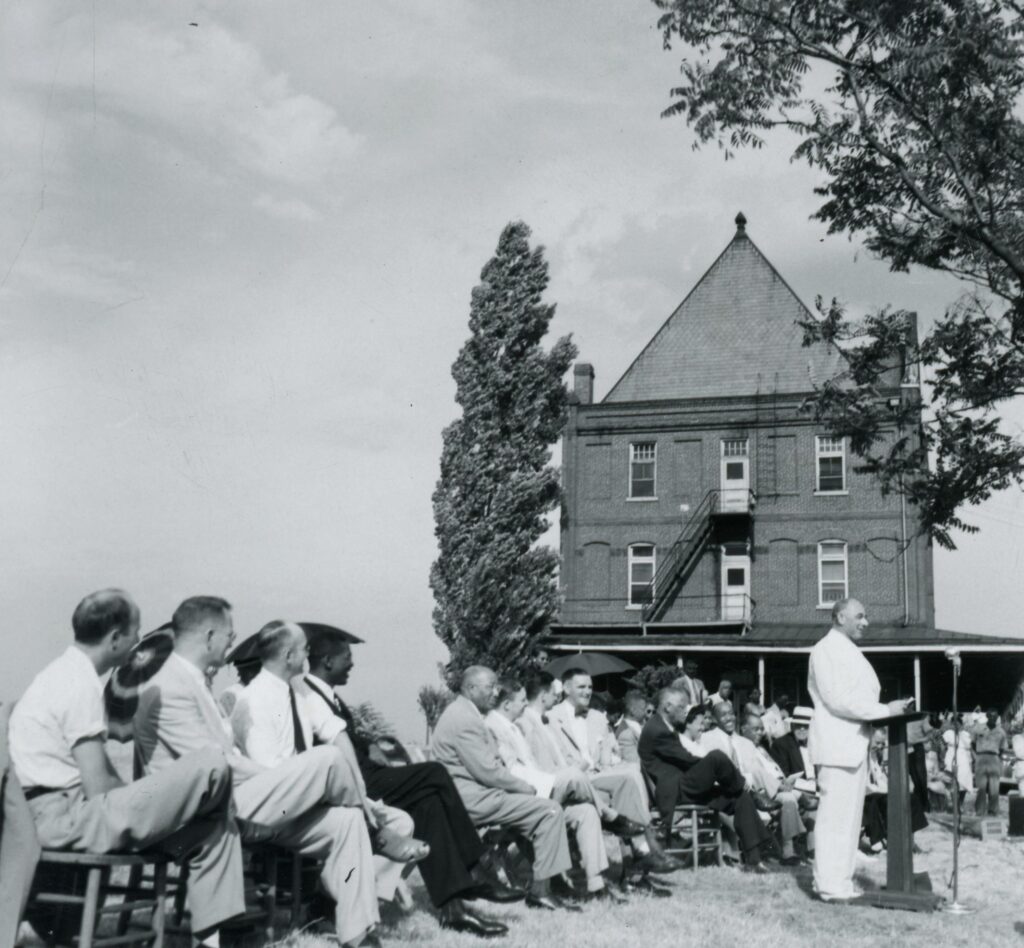Hospital Background
Burrell Memorial Hospital was the only hospital for African Americans in the Roanoke area at a time when health care was segregated. Opened in 1915, its original location was 311 Henry Street, though in 1921 it moved to 611 McDowell Avenue, NW. The hospital was initially conceived by a group of African American Gainsboro physicians: Dr. John B. Claytor, Dr. Jerry S. Cooper, Dr. Shadrach F. Williman, Dr. Lylburn C. Downing, Dr. James H. Roberts, and Dr. Isaac David Burrell. Throughout its history, it remained a non-profit managed by its African American doctors, staff, and representatives of the local community.
Hospital Beginnings
Before the establishment of the hospital, Black physicians in Roanoke did not have adequate access to surgical equipment and sterilized conditions. They often struggled to find suitable facilities to perform major surgery and were forced to practice medicine in substandard conditions. While Roanoke did have adequate medical facilities for its White citizens, such as Roanoke Hospital, which opened in 1900, African Americans could not take advantage of these medical facilities.
Dr. L. C. Downing, Dr. S. F. William, Dr. J. H. Roberts, and Dr. I. D. Burrell initially set up a hospital in 1914 in the home of local physician Dr. Samuel Medley. It consisted of two rooms, one used an operating / sterilizing room and another containing hospital beds, and was known as Medley Hospital. The hospital added beds and took over much of the Medley’s house, displacing Dr. Medley and his family.
More space in a dedicated hospital facility was needed, so the doctors purchased a two-story house at 311 Henry Street, which was reconfigured and modernized to include two operating rooms, ten hospital beds, a kitchen, and nursing quarters. The facility was donated to the newly established Burrell Memorial Hospital Association, a non-profit, charitable organization, which was established to organize, fund, and manage a hospital, with the assistance of an active Women’s Auxiliary. The hospital was named in memory of Dr. Burrell, who died tragically while plans for the medical facility were being developed, illustrating the need for a local Black hospital. The ten-bed Burrell Memorial Hospital opened on March 18, 1915, with the charter listing the Women’s Auxiliary, Dr. J. B. Claytor, Dr. J. H. Roberts, Dr. S. F. Williams, Dr. J. S. Cooper, and Dr. L. C. Downing as supporters.
Moving to McDowell Avenue – 1921
The flu epidemic of 1918 made clear that a larger facility was needed, and in 1921 the hospital moved to 611 McDowell Avenue, which had previously been the Allegheny Institute, a private school for boys. The city owned the building and leased it to the Hospital Association, which raised significant funds to fully renovate and outfit the building. In this three-story, brick building, the hospital included 50 beds, three operating rooms, a dental clinic, a prenatal clinic, and an obstetrical delivery room, as well as an elevator. Burrell Memorial Hospital was highly accredited and was the first African American hospital to earn full approval by the American Board of Surgeons.

This larger facility also provided the space for a nursing school, the Burrell Training School for Nurses, which operated from 1921 to 1934. The School of Practical Nursing succeeded this program in 1958.

New Burrell Memorial Building – 1955
In 1955 a larger building for Burrell Memorial was constructed behind its 1921 location, and the old Allegheny Institute was torn down. In the new building, the hospital added thirty more beds and an emergency care center. Funding for the new building was raised through a local United Fund campaign (in tandem with Roanoke Memorial Hospital), and state and federal dollars.
Burrell Memorial Hospital was a pillar of the Gainsboro community. For many years it was the only hospital in the region that accepted Black patients. Those involved with Burrell Memorial’s operations remember that doctors always treated patients regardless of their financial means, and the majority of patients were not able to pay their hospital bills in full. This in turn, often caused the hospital to suffer financial hardship. However, the hospital continued to offer a high standard of care for its patients.
Closure
Burrell Hospital closed in 1978. It reopened the next year as Burrell Home for Adults, an assisted living center. After declaring bankruptcy in 1980, Burrell was bought by the Roanoke Hospital Association, which later became Carilion Health. The former hospital became the Burrell Nursing Center in 1990. In 2001 the nursing center was closed, and Carilion donated the building to Blue Ridge Behavioral Healthcare for use as a mental health center.
Sources
Blanton, A. & Ferrance, D. (2003). Burrell Memorial Hospital. National Register of Historic Places Inventory/Nomination Form. Virginia Department of Historic Resources, Roanoke, VA, National Register, VDHR #128-5863. https://web.archive.org/web/20130813213331/http://www.dhr.virginia.gov/registers/Cities/Roanoke/128-5863_%20Burrell_Memorial_Hospital_2003_Final_Nomination.pdf
Blue Ridge Behavioral Healthcare. (n.d.). Burrell Center history. Blue Ridge Behavioral Healthcare. Gainsboro Branch Library Vertical Files, Roanoke, VA, United States.
Burrell Memorial Hospital Association, Inc. (1958, March 10). Minutes, held at the Gainsboro Library, 6:59pm to 8:00pm. Gainsboro Library, Roanoke, VA. Gainsboro Branch Library Vertical Files, Roanoke, VA, United States.
Downing, L. C. (1930). Burrell Memorial Hospital, Roanoke, VA. Journal of the National Medical Association, 22(3), 158–159.
Downing, L.C. (1965, March 14). Burrell called monument to fine race relations. The Roanoke Times.
Poindexter, J. & Sturgeon, J. (2002, March 17). Burrell closing opens some wounds. The Roanoke Times.
Pollitt, P. A. (2016). African American and Cherokee Nurses in Appalachia: A History, 1900–1965. McFarland & Company, Inc.
Shareef, R. (1996). The Roanoke Valley’s African American Heritage: A Pictorial History. The Donning Company, Publishers.
